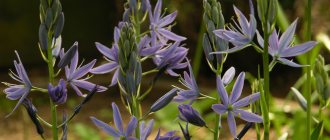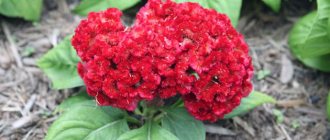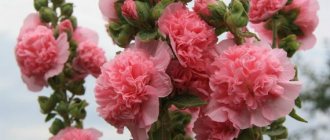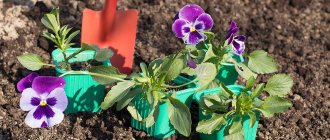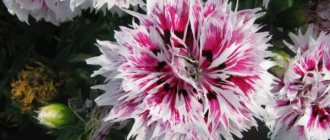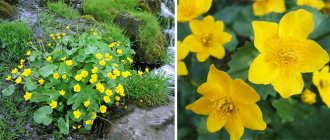Perhaps most of all Purslane known as one of the additives to some soups, marinades or fresh salads. Certain varieties of it can rightfully be called a real storehouse of vitamins beneficial to humans.
Dear readers! For you, we have created communities on social networks in which useful articles and interesting ideas are published several times a day! Subscribe and receive useful content in a convenient format!
When growing Purslane to decorate your garden, it is important not to forget two main rules: this plant loves warmth and a lot of light. The remaining subtleties of caring for it are rather standard and well known to many gardeners.
How to determine the time of sowing Purslane?
Purslane can be called a weather-dependent flower. Firstly, it will not be able to survive a drop in outside temperature below +10°C. Secondly, frequent fluctuations in heat and cold weather also cause serious harm to it.
Therefore, it is often better to sow purslane first as seedlings, and then transfer the already grown sprouts to open ground. As a rule, for most of Russia, transplantation should occur in the second half of May and not earlier.
At the same time, Purslane germinates from seeds for quite a long time - about 2-3 weeks. And it grows on its own for a long time. Therefore, it is customary to plant seedlings at the end of February and the first half of March. Late deadlines, as a rule, are no longer considered by anyone.
REFERENCE. The plant is also known as a weed. But there are other varieties of Purslane - they are distinguished by exceptional decorative properties. For their excellent and long-lasting flowering and fragrant aromas, they are often used to decorate flower beds along with noble roses, asters, crocuses and other famous flowers.
Useful properties of purslane
Purslane was known as a medicinal plant back in the times of Galen and Hippocrates. In those days, people were sure that the seeds of such a plant helped cleanse the body, and its leaves were used as an antidote for snake bites. A paste was made from the leaf blades, which was used to relieve swelling from the eyes, and it was also taken orally with wine, which helped eliminate pain in the bladder, as well as cure a sore stomach. And Arab healers combined finely chopped leaves of such a plant with wine and used the resulting mixture to relieve erysipelas, remove warts and treat acne.
Today, the antiparasitic properties of this flower are widely used in official medicine, and doctors also advise those who suffer from mild diabetes to include it in their diet.
How to prepare planting material for sowing?
Purslane seeds must be treated with a weak solution of potassium permanganate . This will definitely get rid of bacteria, viruses and fungi that could be on them.
ADVICE. Since the seeds are quite small (they are sold in packages of up to 3,000 pieces each), it is recommended to fold a paper funnel and make a very small hole in its narrow part. By pouring the seeds into the funnel, you can plant them in the ground in doses, one grain at a time.
Purslane varieties. Which one is better to choose?
In the 19th century in America, Purslane was generally considered a completely weed that littered landscaped areas. They fought him in every possible way. And today they try and take care to decorate their flower beds. There are currently at least a hundred decorative species alone.
Terry
Terry varieties of Purslane are more striking than others. They bloom with large buds, can open in a variety of shades and, due to the satin surface of the petals, shimmer nobly under the sun's rays. Almost all varieties bloom only during the day, but there are exceptions - the Sanglo or Sundance varieties.
Ampelny
These are most often perennial varieties that have the ability to grow strong and dense stems. These stems are crowned with double flowers no more than 7 cm in diameter. Hanging varieties are almost always grown in flowerpots, on balconies and hanging structures. But some gardeners prefer to decorate ordinary lawns with them too.
Scheherazade
Purslane variety with large flowers up to 4 cm in diameter. It is attractive if only because it can be equally easily grown outdoors, in flowerpots, on balconies and indoors. The main quality of the variety: flowers of various shades, from yellow and white to purple, pink, burgundy and orange.
Large-flowered
The stems of large-flowered varieties are also creeping, but this does not prevent such varieties from being grown in pots. In apartment conditions and an almost unchanged microclimate, they can bloom all year without interruption. Despite their name, the large-flowered Portulaca varieties do not have the largest flowers of any variety. They barely reach 4 cm in diameter.
Decorative
In general, all Purslane varieties with large flowers are considered decorative (the opposite of them are garden varieties - weeds with inconspicuous and barely noticeable flowering). But the Purslane variety “Pun” can be distinguished separately. It has exceptional decorative qualities, as flowers of different shapes and shades grow on it. At the peak of flowering, it looks like a spreading and variegated carpet.
What is vegetable purslane?
This is a rather unpretentious annual plant that can be found throughout the European territory of Russia, where there is stable warmth for at least one season. Garden purslane grows like a weed, and it loves black soil without fertilizers or pesticides. And if he has already appeared on the site, then it will be quite difficult to get him out. You will have to spend more than one year and a lot of effort to fight vegetable purslane. Its root reaches 20 cm in length and quickly produces new shoots if the leaves are torn off.
Propagated by seeds, as well as roots, stems and leaves.
The stems are dense, juicy, but fragile. They are easy to damage by accident, but, thrown on the ground, they take root perfectly within a day.
The leaves are smooth, shiny with visible veins and pores, ovoid or palmate in shape, they also accumulate a lot of juice.
The plant can bloom from July to September with small pale yellow flowers that are not so easy to notice. Inflorescences (less often single flowers) are located in the axils of the leaves.
The fruits of purslane are very small black seeds enclosed in a spherical capsule, less than 1 cm in size.
Purslane is often found along the banks of water bodies. Loves moist soil, but prefers well-lit areas. It does not bloom in the shade. And in the sun it forms thick, dense and beautiful carpets.
When to sow Purslane for seedlings in 2021 according to the lunar calendar?
Experienced gardeners take into account many factors for their seedlings: from traditions, habits, to the weather forecast. But the lunar calendar always takes a special place in choosing the best dates for working with seedlings and growing purslane seedlings from seeds.
Favorable days for sowing Purslane in 2021, depending on the month
Favorable days for planting Purslane in 2021 will be:
- In February : 12, 13, 14, 15, 16, 17, 18, 19, 20, 21, 22, 23, 24, 25, 26.
- In March : 14, 15, 16, 17, 18, 19, 20, 21, 22, 23, 24, 25, 26, 27.
- In April : 13, 14, 15, 16, 17, 18, 19, 20, 21, 22, 23, 24, 25, 26.
- In May : 12, 13, 14, 15, 16, 17,18, 19, 20, 21, 22, 23, 24, 25.
- In June: 11, 12, 13, 14,15, 16, 17,18, 19, 20, 21, 22, 23.
Bad days for planting Purslane in 2021
You will definitely have to avoid the new moon and full moon. On these dates, it is not recommended to plant anything and not even care for the plants in any way (do not water, do not fertilize, do not replant).
In 2021 these days will be:
- In February : new moon – 11th, full moon – 27th, Moon in Aquarius – 10th, 11th,
- In March : new moon - 13th, full moon - 28th, Moon in Aquarius - 9th, 10th, 11th.
- In April : new moon - 12th, full moon - 27th, Moon in Aquarius - 6th, 7th.
- In May : new moon – 11th, full moon – 26th, Moon in Aquarius – 3rd, 4th.
- In June : new moon – 10th, full moon – 24th, Moon in Aquarius – 1st, 27th, 28th.
When to plant depending on the region?
In the case of Purslane, there are some differences in the dates for sowing seedlings in different regions, although these are minor. But gardeners usually reason this way: the approximate time for transplanting Purslane seedlings into open areas is May. Seedlings need about 3 months to grow from a seed to a state in which the plants will survive transplantation and be able to adapt to new conditions.
When to sow purslane in Moscow and the Moscow region
In the Moscow region, in the middle and end of May, the weather is usually consistently warm (and at night too), so that Purslane can easily grow outside. Therefore, seedlings need to be planted at the very beginning of March.
Sowing dates in the middle zone
As in Moscow, throughout the middle zone, Portulac seedlings are planted in early March, and flowers are transplanted in May.
When to plant in the Urals
In the Ural region, it makes sense to plant Portulaca seedlings in early and mid-March, but the timing of transplanting outdoors may be delayed. It is important to wait for return frosts and make sure that even at night the temperature will no longer fall below +10°C. So the optimal time for transplantation may occur either in mid-May or early June.
When to sow and grow seedlings in Siberia
Gardeners in Siberia operate in much the same way as in the Urals. Seedlings are started in March. And they are transplanted based on the observed weather: from late May to mid-June.
Flower sowing time in the Leningrad region
Gardeners in St. Petersburg and the Leningrad region are mainly engaged in Purslane, like their colleagues from the entire central zone. However, it is also important to take into account the changeable northern weather in this region.
If spring has come early, then you can plant the seedlings at the very beginning of March, and plan the transplant for May. If the cold is not in a hurry to recede, then the deadlines are moved forward 2-3 weeks.
Contraindications
No
Portulaca obraceac., portulaceae family.
An annual herbaceous plant with recumbent watery stems 10-30 cm long. The stems are branched. The leaves are opposite, small, thick, elongated wedge-shaped, succulent. The flowers are small, yellow. Blooms in June-September. The smell of the greens is weak, the taste is slightly spicy, tart and refreshing. Purslane grows in vegetable gardens and orchards, along river banks, in fields, wet sandy places, near housing in central Russia, as well as in the Crimea, the Caucasus, Central and Asia Minor , Iran, Mongolia, China. In many countries it is cultivated as a garden plant. A decorative flowering species, purslane grandiflora, brought to us at the beginning of the century before last from South America, is also widespread in cultivation. It can now be found everywhere in our villages, in landscaping - on rocky hills, in carpet beds, flower beds. The flowers are larger than those of P. oleracea, up to 4 centimeters in diameter, of a wide variety of colors - red, lilac, lilac, violet, yellow, orange, white (not petals, but colored sepals), open fully in bright sunlight. Blooms from June until frost.
Purslane must be collected before flowering begins. Later, after flowering, the leaves become hard and have a pungent taste.
In folk medicine, grass and seeds of the garden plant are used. They have anti-inflammatory, diuretic, antiseptic, analgesic effects.
A decoction of purslane herb is used to wash wounds and ulcers. A decoction of purslane seeds is used externally as a lotion for pustular rashes.
Planting Purslane with seeds. Step by step
Seeds in seed pods
Plan for proper planting of Purslane seeds and growing seedlings:
- At the end of February or beginning of March, prepare a container, add 2-5 cm of drainage to the bottom and fill it with nutritious, non-acidic soil (a purchased mixture will do - for succulents).
- Soak Portulaca seeds in a weak solution of potassium permanganate.
- After 20-30 minutes, prepare small grooves in the container (no more than 1 cm deep). Dry the seeds for about 1 hour, placing them on paper or some other material.
- Mix the seeds with river sand and pour into a paper funnel with a hole cut out in its narrow part. Carefully distribute the seeds and sand into the furrows and lightly level the soil.
- Place the container in a warm and bright place (temperature +20-28°C). The higher the temperature, the faster the shoots will appear.
- Pour over warm, settled water. Cover the top with film or glass. Then water every 2-3 days.
- Purslane grows slowly. The first shoots will appear no earlier than in 2 weeks, but optimally they can emerge up to the first 3-4 weeks.
How to plant Purslane peat tablets?
Peat tablets for Purslane will come in handy. Firstly, they will give the plant the necessary amount of nutrients. Secondly, they will make the transplant process easier later (it will be possible to transplant directly in the tablet).
The cultivation steps are absolutely standard. The tablets need to be soaked in water so that they are saturated with moisture for 1-2 hours. Then 2-3 Purslane seeds are planted in special recesses, and about a month later they are planted, leaving one of the strongest sprouts in each tablet.
How to care for Purslane seedlings, what are the tricks when growing?
Purslane is very sensitive to the temperature in the room. After the first shoots have appeared in the mini-greenhouse, you should not change the location of the container. It will still be optimal for her to keep the temperature above +22°C. The warmer it is, the faster and stronger the seedlings grow.
The soil in the container should not dry out too much. Therefore, you must water it with warm water about 3 times a week (every 2 days). Water should be added along the edges of the container, avoiding getting on the leaves and stems of plants.
Lighting will play a big role. Purslane needs at least 14 hours of light a day (if necessary, you will have to organize artificial supplementary lighting).
Purslane seeds have sprouted, what to do next?
It is important to ventilate the container with Purslane immediately on the second day after planting. But at first they do this literally for 10-20 minutes a day, so as not to significantly lower the temperature and slow down the growth of seedlings.
After emergence, more hardening is needed. The sprouts should already be preparing for outdoor growing conditions. Therefore, the lid of the container is removed for several hours a day, gradually increasing the time.
REFERENCE. When the sprouts reach the glass or film on the container, the covering material is removed completely.
In May, 1-2 weeks before replanting, Purslane needs to be taken outside. But it is important to do this carefully. The temperature outside should not be below +15°C - it can destroy all the seedlings.
How to feed Purslane seedlings?
This garden crop requires almost no fertilizing. It is much more important that the soil itself is sufficiently nutritious.
You can limit yourself to adding wood ash to the soil once every month or two.
For ornamental and indoor plants, purchased compositions for Portulaca are suitable.
Purslane picking rules
The first picking is needed only when the sprouts have at least 2-3 leaves. At this moment, Purslane is very weak, so you need to act extremely carefully.
Picking can be done by planting Purslane in separate containers or simply thinning the rows (then you need to leave about 10-15 cm between each sprout).
Immediately after transplantation, it is advisable to fertilize the seedlings with nitrogenous or complex mineral fertilizers. After 2 weeks, feed again.
Step-by-step instruction
Proper sowing of seeds consists of a set of important measures that must be carried out in accordance with all the rules.
Containers and soil
For purslane, ordinary garden soil is suitable, to which you need to add a little sand or vermiculite. But it is better if it is breathable and light soil. Therefore, to loosen it, it is recommended to add high-moor peat (the same amount as soil).
Important! Purslane is susceptible to blackleg, so the soil is heated in the oven or microwave for 30 minutes before sowing the seeds.
Purslane is best grown in wide and shallow boxes. However, sowing can also be carried out in individual containers: plastic cassettes, cups, peat pots, or tablets.
Important! There should be drainage holes at the bottom of the container to remove excess moisture and watering, which is carried out through the pan.
Seed preparation
Purslane seeds are first soaked in a solution of growth stimulator Epin or Zircon according to the instructions .
After this, they are strained through thick cotton cloth and allowed to dry.
Interesting! Pre-sowing preparation may not be carried out, but for quick and friendly seedlings, this procedure should not be ignored.
Sowing seedlings
The sowing scheme is simple, even a novice gardener can cope with it:
- A 1.5 cm drainage layer is laid on the bottom of the container. You can use perlite, expanded clay, pebbles, and broken brick.
- Next, pour the prepared soil, but not to the edges.
- Moisten the soil with a spray bottle with soft, clean and warm water.
- Lightly compact.
- Small seeds are scattered evenly over the surface of the soil. For convenience, they can be mixed with sand.
Sowing option! To the snow. Clean snow is laid out on the ground and purslane seeds are scattered. When the snow melts, the seed will be drawn into the ground.
- Spray with warm water from a spray bottle (you can use a solution of growth stimulator Epin, Zircon).
- The containers are covered with glass or film.
- The name of the crop and the planting date, if necessary, are written on each container.
- The containers are left in a bright place with an air temperature of about 25 degrees.
Seedling care
In order for the seedlings to grow healthy and strong, you need to properly care for them:
- Before emergence, the film is removed every day for ventilation for 20 minutes and the condensation is wiped off.
- After seed germination, the film is removed forever.
Important! With proper care, the first shoots will appear in 4-5 days.
Watch the video! Purslane. sowing purslane seeds. review of seedlings
Picking
Picking is carried out when 2 true leaves appear on the sprouts.
In this case, the same soil is used as for sowing seeds. Picking is carried out in separate plastic cups with drainage holes at the bottom, or in peat pots with a diameter of 5-10 cm.
Picking scheme:
- Soil is poured into new containers.
- A small depression is made in the center.
- Using a plastic spoon or wooden stick, dig up several seedlings with soil.
- Transfer the seedlings to the hole.
- Carefully fill the hole, lightly tamping it down.
- The cups are placed on a tray with water so that the soil is saturated with moisture.
After picking, care for the sprouts in the same way as before this procedure.
Is it possible to immediately sow seeds in open ground?
Yes, Purslane is sometimes immediately sown in open ground, but in fact this method is only suitable for the southernmost regions of Russia and Ukraine. The more severe the climate and the more often temperature changes occur in it, the more correct it is to give preference to seedlings rather than direct sowing.
Seeds in open ground will take longer to germinate. They will be planted in April, and the first flowers are unlikely to appear before July.
BY THE WAY . Purslane is self-seeding. Gardeners recommend collecting scattered seeds from seed pods in the fall and storing them in a dry and cool place until next spring.
Caring for purslane
For normal growth and development, purslane grown in open ground requires systematic watering. Despite the fact that its leaves can retain moisture, if the bushes are watered at the wrong time, this will have an extremely negative effect on flowering. This flower will not need any weeding, fertilizing, pruning throughout the entire growing season, and you will not have to loosen the surface of the soil near the bushes. Caring for purslane comes down to timely watering.
Purslane - GROWING CARE
Diseases and pests
Even a novice gardener can grow purslane, and even someone who doesn’t have enough time to care for flowers can do it. There is also nothing difficult in growing terry purslane, since sowing and caring for it is no different from cultivating large-flowered or garden purslane.
A gardener rarely has problems with such a flower, because it is highly resistant to both diseases and harmful insects. But in those years when a large number of aphids attack the gardens, purslane may also suffer from them. In order to get rid of such a sucking pest, experts advise resorting to the help of an insecticidal preparation. For example, Actellik effectively fights aphids, the solution of which must be used to treat purslane; if necessary, re-spraying is carried out after 7 days.
Quite rarely, but still, purslane can infect the fungus Albugo portulaceae. In this case, the stems of the diseased plant become deformed, and spots form on its foliage. All affected parts will need to be pruned, after which the bushes are treated with a copper-containing fungicidal agent.
Answers to frequently asked questions
We will answer the most popular questions regarding growing purslane seedlings.
What soil should I buy for growing seedlings?
For Purslane, choose light, loose and nutritious soils. You should not use loamy soils at all. Also, the flower does not tolerate peat in the soil mixture.
Among the purchased mixtures, take a closer look at the soil for succulents.
How can you stimulate seeds for further growth?
Classics: Kornevin, Epin. However, you should not count on a significant reduction in growth periods. Whether with or without stimulants, Purslane seedlings need about 3 months to prepare for transplanting into open ground.
Why don't the seeds germinate?
In the case of Purslane, growth is seriously retarded if the seeds do not receive enough heat. The seedlings should be kept in a room where the temperature is above +20°C and hardly changes during the day.
Why are seeds soaked?
Soaking is needed to awaken dormant growth processes.
How to harden purslane seedlings?
Standard. Start ventilating the greenhouse with seedlings for 30 minutes a day and gradually increasing. Before planting, as a matter of course, the containers should be taken outside.
What to do if Portulaca seedlings do not grow?
Place it in a warmer place and provide additional lighting with lamps.
Description
Portulaca oleracea An annual herbaceous plant of the portulaca family, 10–30 cm high.
The root is spindle-shaped, branched.
The stem is bare, fleshy, arched, branched, often pressed to the ground or erect, brown.
The leaves are green, juicy, fleshy, green or yellowish in color, alternate, the upper ones are almost opposite, sessile - spatulate, obtuse, narrowed towards the base, oval, reminiscent of a flattened egg.
The flowers are small, white, yellow, sometimes dark brown, sessile, solitary or in bunches of two or three in the branches of the stem or the axils of the leaves.
The seeds are very small, dark gray in color.
Blooms from June to September.
Spreading
Purslane is cultivated in the south of the European part of Russia, in the Far East, Transcaucasia and Central Asia.
It grows wild on sandbanks, weedy places, along river banks, near villages, in gardens and along the edges of fields.
Conclusion
Today, Purslane is often used to decorate various elements of landscape design. It can be found in ordinary flower beds or complex compositions such as alpine slides, multi-tiered gardens with the obligatory presence of flowerpots, flowerpots of different sizes, etc.
Caring for flowering varieties can be called simple, but you also need to know your subtleties when growing. If everything is done correctly, Purslane will, firstly, delight you with high-quality flowering, and secondly, it will decorate the flowerbeds for quite a long time - from the end of spring until the first frost.



